
The sharp-tailed sandpiper is a small wader.
Gustavia acuminata is a species of woody plant in the family Lecythidaceae. It is found in Brazil and Venezuela. It is threatened by habitat loss.

The Tucumán amazon, also known as the alder amazon, Tucumán parrot, or alder parrot, is a species of parrot in the family Psittacidae. It is mainly green and has red at the front of its head above its pale beak. It is found in woodland in the Yungas of Argentina and Bolivia. It is threatened by habitat loss and capture for the parrot trade.
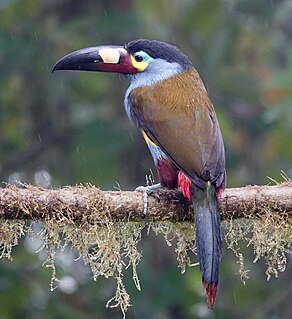
The plate-billed mountain toucan is a species of bird in the family Ramphastidae. It is native to the west slope of Ecuador and extreme southern Colombia, where it lives in the high-altitude humid montane forests of the Andes. It is also known as the laminated hill-toucan, laminated mountain-toucan, and plain-billed mountain-toucan.

The Ugandan lowland shrew is a species of mammal in the family Soricidae. It is found in Kenya and Uganda. Its natural habitats are subtropical or tropical swamps and subtropical or tropical moist montane forest. It is threatened by habitat loss.

Babault's mouse shrew is a species of mammal in the family Soricidae found in Burundi, the Democratic Republic of the Congo, and Uganda. Its natural habitat is subtropical or tropical moist montane forests. It is threatened by habitat loss.
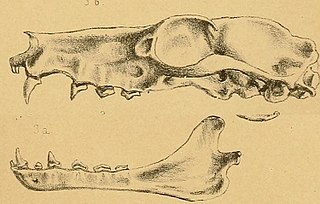
The Angolan epauletted fruit bat is a species of megabat in the family Pteropodidae. It is found in Angola and Namibia. Its natural habitats are dry savanna and moist savanna. It is threatened by habitat loss.
Jardinella acuminata is a species of small freshwater snails, aquatic gastropod mollusks in the family Tateidae.
Brassaiopsis acuminata is a species of plant in the family Araliaceae. It is endemic to China.
Calochone is a genus of flowering plants in the family Rubiaceae. The genus is found in Cameroon, Gabon, Cabinda Province, Republic of the Congo, and Democratic Republic of the Congo.
Cassipourea acuminata is a species of plant in the Rhizophoraceae family. It is found in Cameroon, the Democratic Republic of the Congo, and Gabon. Its natural habitats are subtropical or tropical moist lowland forests and subtropical or tropical swamps. It is threatened by habitat loss.

Kirkia is a genus of plant in family Kirkiaceae. It was previously placed in family Simaroubaceae, but was transferred into Kirkiaceae, together with Pleiokirkia, because these genera produce neither quassinoids nor limonoids.
Otoba acuminata is a species of plant in the family Myristicaceae found in Costa Rica, Ecuador, and Panama. It is threatened by habitat loss.
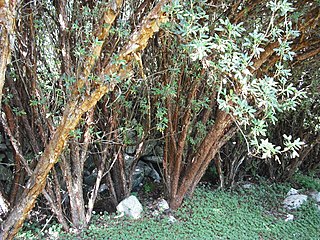
Polylepis racemosa is a species of small tree in the family Rosaceae. It is endemic to Peru, Bolivia, and Ecuador. It is threatened by habitat destruction. The International Union for Conservation of Nature has assessed the conservation status of this tree as "vulnerable".

Terminalia acuminata is a tree species in the Combretaceae family. It was endemic to the Atlantic Forest in Brazil. The species was believed to be extinct in the wild from habitat loss, entering the IUCN Red List in 1998, with two individuals remaining in the Rio de Janeiro Botanical Garden.
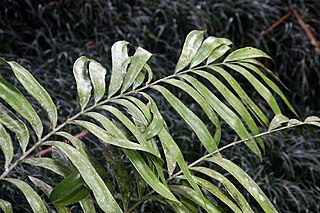
Zamia acuminata is a species of plant in the family Zamiaceae which is threatened by habitat loss. It is found in Costa Rica, Nicaragua, and Panama.
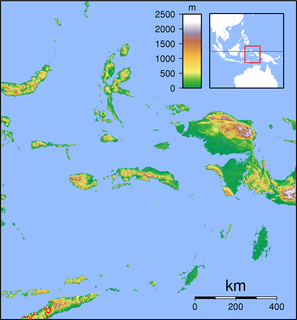
Manusela National Park is located on Seram island, in the Maluku archipelago of Indonesia. It is made up of coastal forest, swamp forest, lowland and montane rainforest ecosystem types. Mount Binaiya at 3,027 meters, is the highest of the park's six mountains. Seram is remarkable for its high degree of localised bird endemism. The park also includes important karst landscapes. On Mount Hatu Saka, near the coast of Saleman-Sawai, it is the Goa Hatusaka, currently the deepest cave of the whole Indonesia.
Cyanea acuminata is a rare species of flowering plant known by the common names Honolulu cyanea. It is endemic to Oahu, where there are no more than 250 individuals remaining. It is a federally listed endangered species of the United States. Like other Cyanea it is known as haha in Hawaiian.
Dioscorea acuminata is a herbaceous vine in the family Dioscoreaceae, which is listed as an endangered species by the IUCN Red List. It is indigenous to the central plateau of Madagascar where it occurs on rocky substrate in a grassland-woodland mosaic habitat. There is confusion as to whether the tuber is harvested for consumption by humans as field researchers likely misidentified Dioscorea maciba as this species. However, the IUCN Red List also has an entry for D. maciba which does not cite that species as being consumed by humans.
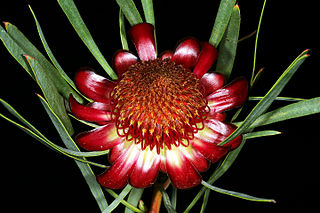
Protea acuminata, also known in English as the black-rim sugarbush, or in the Afrikaans language as sederbergsuikerbos, is a flowering shrub belonging to the genus Protea. The plant is endemic to South Africa. There are isolated populations at Nieuwoudtville, and in the Cederberg, Stettynskloof and Riviersonderend Mountains. It can grow as an upright tree. It can become up to two metres in height. It blooms from June to September, with the peak of July to August. Periodic wildfires may destroy the adult plants, but the seeds can survive such an event. The seeds are dispersed by means of the wind. The plant is monoecious with both sexes in each flower. It is unknown what causes the pollination to occur. The plant grows in sandy plains and coastal lowlands from sea-level to altitudes of 400 metres. It is a widespread species which is not in danger, and the conservation status has been assessed as 'least concern'.












